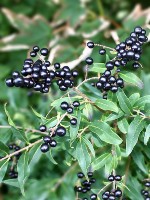Mon-Fri 9am - 5pm Mountain time
Black Raspberry vs Wild Privet
Rubus occidentalis
Ligustrum vulgare
NOT AVAILABLE THIS SEASON - MIGHT RETURN
The Black Raspberry is a multi-stemmed shrub that produces edible red berries that deepen to black as they mature. The berries are flavorful and are great for fresh eating and preserves. Black Raspberry shrubs bloom in late spring with white, rose-like flowers and attract many pollinators such as bees and butterflies.
Black Raspberries are floricanes primarily fruiting on second year canes. Each spring cut back all two-year old canes, leaving only the last year’s growth.
Wild Privet is a fast growing ornamental shrub that is well suited for forming hedges and privacy screens. It will retain its leaves in warmer climates but drops them in colder areas. They have small white flowers, though the smell is often considered unpleasant. While the berries are inedible, they are a good food source for many bird species.
It is recommended to prune Wild Privet immediately after flowering, as it can readily self seed. It is deer and rabbit tolerant. It can grow in dry areas, on slopes, and withstand the wind making it well suited for many growing conditions.
Black Raspberry Quick Facts
Wild Privet Quick Facts
Toxicity: If ingested, all parts of this plant will cause severe discomfort. Toxic to dogs, cats, and horses

